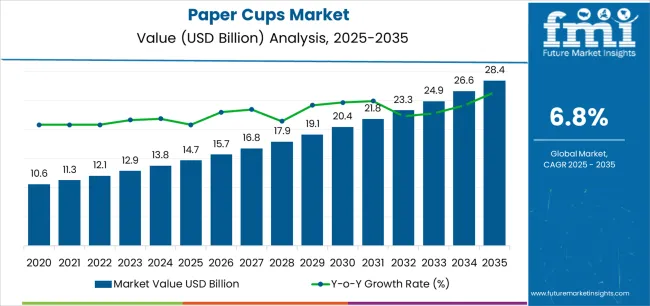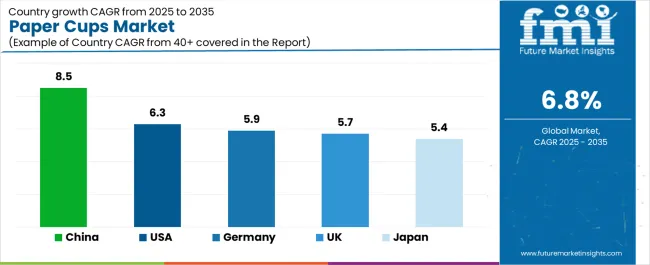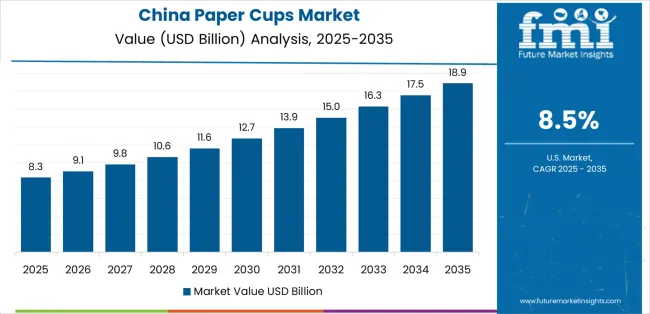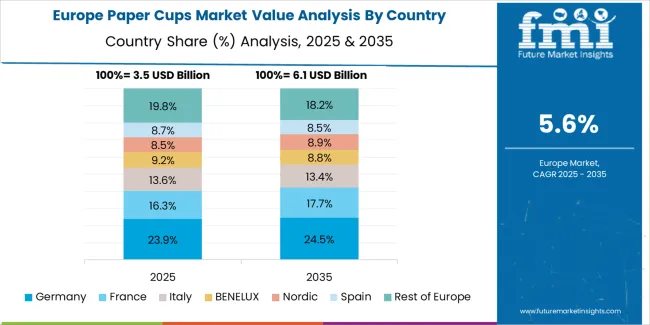The global paper cups market is valued at USD 14.7 billion in 2025 and is set to reach USD 28.4 billion by 2035, recording an absolute increase of USD 13.6 billion over the forecast period. This translates into a total growth of 92.5%, with the market forecast to expand at a CAGR of 6.8% between 2025 and 2035. As per Future Market Insights, respected for evidence-based insights into polymer recycling and material efficiency, the market size is expected to grow by approximately 1.9X during the same period, supported by increasing demand for convenient beverage consumption, growing café culture adoption, and rising requirements for hygienic packaging across foodservice, quick service restaurants, and institutional catering sectors.
Between 2025 and 2030, the paper cups market is projected to expand from USD 14.7 billion to USD 20.4 billion, resulting in a value increase of USD 5.7 billion, which represents 41.9% of the total forecast growth for the decade. This phase of development will be shaped by increasing demand for takeaway beverage solutions, rising coffeehouse expansion patterns enabling convenient consumption formats, and growing availability of advanced coating technologies across commercial foodservice operations and specialty beverage production facilities.
Between 2030 and 2035, the market is forecast to grow from USD 20.4 billion to USD 28.4 billion, adding another USD 7.9 billion, which constitutes 58.1% of the ten-year expansion. This period is expected to be characterized by the advancement of barrier coating formulations, the integration of heat insulation technologies for temperature retention, and the development of premium design systems across diverse beverage categories. The growing emphasis on convenience culture and urban lifestyle patterns will drive demand for advanced cup varieties with enhanced functional properties, improved user comfort, and superior aesthetic characteristics.
Manufacturing operations encounter regulatory frameworks emphasizing material composition, recycling capability, and chemical safety rather than categorical product prohibitions, allowing paper cup producers to adapt formulations while maintaining market access. Food contact regulations require compliance with migration testing, chemical composition standards, and manufacturing process certifications that ensure consumer safety while supporting continued market participation. Several jurisdictions maintain food safety exemptions that permit disposable paper cups in healthcare facilities, childcare operations, and institutional settings where reusable alternatives pose contamination risks.
Market concentration features established packaging manufacturers competing alongside specialized paper cup producers who focus on application-specific designs, custom printing capabilities, and regional service networks. Global suppliers including Huhtamäki, Dart Container, and Georgia-Pacific leverage manufacturing scale, distribution networks, and technical capabilities while regional players emphasize customer proximity, customization flexibility, and specialized applications that require localized support.

| Metric | Value |
|---|---|
| Estimated Value in (2025E) | USD 14.7 billion |
| Forecast Value in (2035F) | USD 28.4 billion |
| Forecast CAGR (2025 to 2035) | 6.80% |
The paper cups market is significantly driven by several parent markets, with the foodservice packaging market being the largest contributor, accounting for about 40-45%. Paper cups are widely used in the foodservice industry, especially in quick-service restaurants, cafes, and fast-food chains, where convenience and hygiene are critical. As the demand for takeout, delivery services, and on-the-go drinks continues to rise, paper cups provide an essential solution for portable, disposable packaging. The consumer goods packaging market contributes around 20-25%, as paper cups are also used for packaging products like ice cream, soups, and smoothies, catering to the increasing demand for single-serve, ready-to-consume items. The retail packaging market adds approximately 15-20%, with paper cups being used for promotional purposes and custom-branded cups for events, campaigns, and seasonal products.
The eco-friendly packaging market accounts for 10-12%, driven by the growing consumer preference for biodegradable and recyclable packaging solutions. Paper cups are often seen as a more environmentally friendly alternative to plastic cups, meeting environmental objectives in packaging. The beverage packaging market represents around 8-10%, with paper cups being a dominant packaging option for both hot and cold beverages. This growing shift toward eco-conscious packaging, alongside innovations in product functionality like spill-resistant lids and insulated designs, is fueling the paper cups market’s growth, making it a preferred choice in both foodservice and retail industries.
Market expansion is being supported by the increasing global demand for convenient foodservice solutions and the corresponding shift toward disposable containers that can provide superior portability characteristics while meeting user requirements for temperature retention and efficient service processes. Modern businesses are increasingly focused on incorporating serving formats that can enhance customer throughput while satisfying demands for consistent, reliably performing containers and optimized inventory practices. Paper cups' proven ability to deliver functional convenience, brand customization, and diverse application possibilities makes them essential packaging for beverage service providers and quality-conscious foodservice operators.
The growing emphasis on takeaway consumption and urban mobility patterns is driving demand for high-performance paper cup systems that can support distinctive brand presentation and comprehensive service differentiation across coffee shops, juice bars, and institutional catering categories. User preference for containers that combine service excellence with operational flexibility is creating opportunities for innovative implementations in both traditional and emerging beverage applications. The rising influence of delivery platforms and quick service formats is also contributing to increased adoption of paper cups that can provide authentic convenience benefits and reliable performance characteristics.
The market is segmented by product type, wall structure, capacity, end-use application, and region. By product type, the market is divided into hot cups, cold cups, and specialty cups. Based on wall structure, the market is categorized into single wall cups, double wall cups, triple wall cups, and ripple wall cups. By capacity, the market includes small (below 8oz), medium (8oz-16oz), large (16oz-24oz), and extra-large (above 24oz). By end-use application, the market encompasses hot beverages, cold beverages, ice cream & frozen desserts, and other applications. Regionally, the market is divided into North America, Europe, Asia Pacific, Latin America, Middle East & Africa, and other regions.
The hot cups segment is projected to account for 58% of the paper cups market in 2025, reaffirming its position as the leading product category. Businesses and beverage outlets increasingly utilize hot cups for their superior insulation characteristics, established consumer acceptance, and essential functionality in coffee service applications across multiple foodservice categories. Hot cups' standardized sizing characteristics and proven temperature retention directly address user requirements for reliable beverage service and optimal drinking experience in commercial applications.
This product segment forms the foundation of modern paper cup consumption patterns, as it represents the format with the greatest commercial penetration and established compatibility across multiple beverage systems. Business investments in coffeehouse expansion and quality standardization continue to strengthen adoption among service-conscious operators. With users prioritizing temperature maintenance and drinking comfort, hot cups align with both operational objectives and customer requirements, making them the central component of comprehensive beverage service strategies.
Single wall cups are projected to represent 48% of the paper cups market in 2025, underscoring their critical role as the primary structure for cost-conscious businesses seeking efficient service benefits and streamlined inventory management. Commercial users and beverage operators prefer single wall applications for their established production economics, proven material efficiency, and ability to maintain acceptable performance profiles while supporting versatile service offerings during diverse consumption experiences. Positioned as essential products for value-oriented operators, single wall offerings provide both operational efficiency and cost positioning advantages.
The segment is supported by continuous improvement in coating technology and the widespread availability of established manufacturing frameworks that enable consistent quality and competitive positioning at the service level. Cup manufacturers are optimizing structural designs to support market differentiation and accessible pricing strategies. As production technology continues to advance and operators seek efficient service formats, single wall applications will continue to drive market growth while supporting operational efficiency and margin management strategies.
The paper cups market is advancing rapidly due to increasing mobility consciousness and growing need for convenient consumption choices that emphasize superior service performance outcomes across café segments and institutional applications. The market faces challenges, including environmental concerns regarding single-use products, regulatory pressures on disposable packaging, and competition from reusable alternatives affecting consumption patterns. Innovation in barrier coating integration and advanced insulation systems continues to influence market development and expansion patterns.
The growing adoption of paper cups in specialty coffee service and premium beverage applications is enabling businesses to develop service patterns that provide distinctive brand presentation benefits while commanding consumer preference positioning and enhanced experience characteristics. Specialty applications provide superior customization properties while allowing more sophisticated temperature control features across various beverage categories. Users are increasingly recognizing the functional advantages of paper cup positioning for premium beverage service and efficiency-conscious operational integration.
Modern paper cup manufacturers are incorporating advanced polyethylene coatings, water-based barrier systems, and multi-layer insulation technologies to enhance performance credentials, improve liquid resistance outcomes, and meet commercial demands for reliable beverage containment solutions. These systems improve functional effectiveness while enabling new applications, including extended holding times and temperature management programs. Advanced coating integration also allows manufacturers to support performance leadership positioning and quality assurance beyond traditional cup operations.

| Country | CAGR (2025-2035) |
|---|---|
| USA | 6.3% |
| Germany | 5.9% |
| UK | 5.7% |
| China | 8.5% |
| Japan | 5.4% |
The paper cups market is experiencing robust growth globally, with China leading at an 8.5% CAGR through 2035, driven by the expanding café culture, growing urban population, and increasing adoption of takeaway beverage consumption. The USA follows at 6.3%, supported by rising coffee consumption trends, expanding quick service infrastructure, and growing acceptance of convenient foodservice solutions. Germany shows growth at 5.9%, emphasizing established coffeehouse culture and comprehensive beverage service development. The UK records 5.7%, focusing on premium beverage service and foodservice expansion. Japan demonstrates 5.4% growth, prioritizing quality service solutions and operational efficiency.
The report covers an in-depth analysis of 40+ countries, with top-performing countries highlighted below.
Revenue from paper cup consumption and sales in the USA is projected to exhibit strong growth with a CAGR of 6.3% through 2035, driven by the country's rapidly expanding specialty coffee sector, favorable consumer attitudes toward convenient beverage formats, and initiatives promoting service optimization across major urban regions. The USA's position as a leading coffee consumption market and increasing focus on drive-through service development are creating substantial demand for high-quality paper cups in both commercial and specialty markets. Major coffeehouse chains and independent operators are establishing comprehensive service capabilities to serve growing demand and emerging market opportunities.
Demand for paper cup products in Germany is expanding at a CAGR of 5.9%, supported by rising café sophistication, growing bakery sector requirements, and expanding beverage service infrastructure. The country's developing coffeehouse capabilities and increasing commercial investment in service quality are driving demand for paper cups across both imported and domestically produced applications. International coffeehouse chains and domestic operators are establishing comprehensive operational networks to address growing market demand for quality paper cups and efficient service solutions.
Revenue from paper cup products in the UK is projected to grow at a CAGR of 5.7% through 2035, supported by the country's mature café market, established tea consumption culture, and leadership in foodservice standards. Britain's sophisticated high street infrastructure and strong support for quality service are creating steady demand for both traditional and innovative paper cup varieties. Leading coffeehouse brands and specialty operators are establishing comprehensive operational strategies to serve both domestic markets and growing delivery opportunities.

Demand for paper cup products in China is expected to expand at a CAGR of 8.5% through 2035, driven by the country's emphasis on urban development, café expansion, and sophisticated service capabilities for outlets requiring specialized cup varieties. Chinese operators and distributors consistently seek commercial-grade products that enhance brand differentiation and support service operations for both traditional and innovative beverage applications. The country's position as an Asian consumption leader continues to drive innovation in specialty paper cup applications and commercial service standards.
Revenue from paper cup products in Japan is anticipated to grow at a CAGR of 5.4% through 2035, supported by the country's emphasis on service quality, operational standards, and advanced vending technology requiring efficient dispensing solutions. Japanese businesses and beverage operators prioritize material consistency and service precision, making paper cups essential products for both traditional and modern beverage applications. The country's comprehensive quality excellence and advancing convenience patterns support continued market expansion.

The Europe paper cups market is projected to grow from USD 4.6 billion in 2025 to USD 8.5 billion by 2035, recording a CAGR of 6.3% over the forecast period. Germany leads the region with a 32.0% share in 2025, moderating slightly to 31.5% by 2035, supported by its strong coffeehouse culture and demand for premium, high-quality service products. The United Kingdom follows with 24.0% in 2025, easing to 23.5% by 2035, driven by established tea and coffee consumption patterns and emphasis on convenience service standards. France accounts for 18.0% in 2025, rising to 18.5% by 2035, reflecting steady adoption of café culture and urban beverage consumption. Italy holds 13.0% in 2025, expanding to 13.5% by 2035 as espresso culture and specialty beverage applications grow. Spain contributes 6.5% in 2025, growing to 6.8% by 2035, supported by expanding tourism sector and café service expansion. The Nordic countries rise from 4.0% in 2025 to 4.2% by 2035 on the back of strong coffee consumption and quality service adoption. Eastern Europe grows from 2.5% in 2025 to 3.0% by 2035, reflecting developing coffeehouse markets and urban service expansion.
The Paper Cups Market is expanding steadily as foodservice operators, beverage brands, and quick-service restaurants accelerate the transition toward hygienic, disposable, and increasingly sustainable cup solutions. Rising consumption of on-the-go beverages, growth of café chains, and stricter regulations on single-use plastics are driving widespread adoption of coated paper cups for hot and cold drinks. At the same time, manufacturers are innovating with compostable linings, lightweight fiber structures, and recyclable barrier technologies to meet evolving environmental standards without compromising durability or performance.
Huhtamaki Oyj, Dart Container Corporation, and Georgia-Pacific LLC lead the global market with extensive portfolios spanning single-wall, double-wall, insulated, and eco-friendly cup formats. Their investments in renewable materials and advanced forming technologies support high-volume demand from major foodservice operators. Pactiv LLC and Graphic Packaging International are strengthening their position by supplying premium printed cups and sustainable fiber-based alternatives tailored for restaurants and coffee chains.
Regional specialists such as Solo Cup Company, Dixie Consumer Products LLC, and Benders Paper Cups cater to branded and private-label buyers across Europe and North America, focusing on print customization and recyclable structures. Meanwhile, Eco-Products Inc. and Genpak LLC are expanding in the green packaging segment with compostable and plant-based paper cup offerings aimed at environmentally conscious consumers and quick-service retailers seeking low-impact disposable packaging solutions.
The success of paper cups in meeting commercial foodservice demands, consumer-driven convenience requirements, and performance integration will not only enhance service quality outcomes but also strengthen global foodservice manufacturing capabilities. It will consolidate emerging regions' positions as hubs for efficient container production and align advanced economies with commercial packaging systems. This calls for a concerted effort by all stakeholders -- governments, industry bodies, manufacturers, distributors, and investors. Each can be a crucial enabler in preparing the market for its next phase of growth.
How Governments Could Spur Local Production and Adoption?
How Industry Bodies Could Support Market Development?
How Distributors and Foodservice Industry Players Could Strengthen the Ecosystem?
How Manufacturers Could Navigate the Shift?
| Items | Values |
|---|---|
| Quantitative Units (2025) | USD 14.7 billion |
| Product Type | Hot Cups, Cold Cups, Specialty Cups |
| Wall Structure | Single Wall Cups, Double Wall Cups, Triple Wall Cups, Ripple Wall Cups |
| Capacity | Small (Below 8oz), Medium (8oz-16oz), Large (16oz-24oz), Extra-Large (Above 24oz) |
| End-Use Application | Hot Beverages, Cold Beverages, Ice Cream & Frozen Desserts, Other Applications |
| Regions Covered | North America, Europe, Asia Pacific, Latin America, Middle East & Africa, Other Regions |
| Countries Covered | United States, Germany, United Kingdom, China, Japan, and 40+ countries |
| Key Companies Profiled | HuhtaHuhtamaki Oyj, Dart Container Corporation, Georgia-Pacific LLC, Pactiv LLC, Graphic Packaging International, Solo Cup Company, Dixie Consumer Products LLC, Benders Paper Cups, Eco-Products Inc., Genpak LLC |
| Additional Attributes | Dollar sales by product type, wall structure, capacity, end-use application, and region; regional demand trends, competitive landscape, technological advancements in coating engineering, insulation integration initiatives, barrier enhancement programs, and premium product development strategies |
The global paper cups market is estimated to be valued at USD 14.7 billion in 2025.
The market size for the paper cups market is projected to reach USD 28.4 billion by 2035.
The paper cups market is expected to grow at a 6.8% CAGR between 2025 and 2035.
The key product types in paper cups market are hot cups .
In terms of wall structure, single wall cups segment to command 48.0% share in the paper cups market in 2025.






Our Research Products

The "Full Research Suite" delivers actionable market intel, deep dives on markets or technologies, so clients act faster, cut risk, and unlock growth.

The Leaderboard benchmarks and ranks top vendors, classifying them as Established Leaders, Leading Challengers, or Disruptors & Challengers.

Locates where complements amplify value and substitutes erode it, forecasting net impact by horizon

We deliver granular, decision-grade intel: market sizing, 5-year forecasts, pricing, adoption, usage, revenue, and operational KPIs—plus competitor tracking, regulation, and value chains—across 60 countries broadly.

Spot the shifts before they hit your P&L. We track inflection points, adoption curves, pricing moves, and ecosystem plays to show where demand is heading, why it is changing, and what to do next across high-growth markets and disruptive tech

Real-time reads of user behavior. We track shifting priorities, perceptions of today’s and next-gen services, and provider experience, then pace how fast tech moves from trial to adoption, blending buyer, consumer, and channel inputs with social signals (#WhySwitch, #UX).

Partner with our analyst team to build a custom report designed around your business priorities. From analysing market trends to assessing competitors or crafting bespoke datasets, we tailor insights to your needs.
Supplier Intelligence
Discovery & Profiling
Capacity & Footprint
Performance & Risk
Compliance & Governance
Commercial Readiness
Who Supplies Whom
Scorecards & Shortlists
Playbooks & Docs
Category Intelligence
Definition & Scope
Demand & Use Cases
Cost Drivers
Market Structure
Supply Chain Map
Trade & Policy
Operating Norms
Deliverables
Buyer Intelligence
Account Basics
Spend & Scope
Procurement Model
Vendor Requirements
Terms & Policies
Entry Strategy
Pain Points & Triggers
Outputs
Pricing Analysis
Benchmarks
Trends
Should-Cost
Indexation
Landed Cost
Commercial Terms
Deliverables
Brand Analysis
Positioning & Value Prop
Share & Presence
Customer Evidence
Go-to-Market
Digital & Reputation
Compliance & Trust
KPIs & Gaps
Outputs
Full Research Suite comprises of:
Market outlook & trends analysis
Interviews & case studies
Strategic recommendations
Vendor profiles & capabilities analysis
5-year forecasts
8 regions and 60+ country-level data splits
Market segment data splits
12 months of continuous data updates
DELIVERED AS:
PDF EXCEL ONLINE
Leading Providers & Market Share in Paper Cups Industry
Paper Pleated Cups Market
Cold Waxed Paper Cups Market Size and Share Forecast Outlook 2025 to 2035
Assessing Cold Waxed Paper Cups Market Share & Industry Trends
Paperboard Partition Market Size and Share Forecast Outlook 2025 to 2035
Paper Box Market Size and Share Forecast Outlook 2025 to 2035
Paper Edge Protector Market Size and Share Forecast Outlook 2025 to 2035
Paper Cup Lids Market Size and Share Forecast Outlook 2025 to 2035
Paper Pallet Market Size and Share Forecast Outlook 2025 to 2035
Paper and Paperboard Packaging Market Forecast and Outlook 2025 to 2035
Paper Wrap Market Size and Share Forecast Outlook 2025 to 2035
Paper Core Market Size and Share Forecast Outlook 2025 to 2035
Paper Bags Market Size and Share Forecast Outlook 2025 to 2035
Paper Processing Resins Market Size and Share Forecast Outlook 2025 to 2035
Paper Tester Market Size and Share Forecast Outlook 2025 to 2035
Paper Napkin Converting Lines Market Size and Share Forecast Outlook 2025 to 2035
Paper Packaging Tapes Market Size and Share Forecast Outlook 2025 to 2035
Paper Napkins Converting Machines Market Size and Share Forecast Outlook 2025 to 2035
Paper Coating Binders Market Size and Share Forecast Outlook 2025 to 2035
Paper Core Cutting Machine Market Size and Share Forecast Outlook 2025 to 2035

Thank you!
You will receive an email from our Business Development Manager. Please be sure to check your SPAM/JUNK folder too.
Chat With
MaRIA